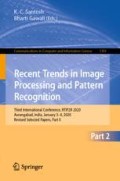Abstract
Criminal activities have increased largely over the past couple of years and the security of the commoners especially women have been hugely jeopardized. There has been multifarious cases of threats and assaults with weapons in the present days especially with knives which are one of the most common and readily available household items. Such cases have made CCTV cameras a common sighting in the neighbourhood. The prime idea behind their installation is surveillance. The footage from such cameras can serve as an extremely important source of evidence during investigation. However, such systems only make themselves useful as evidences of a crime and do not aid in prevention of a crime in progress. Standing in such times, making CCTV cameras intelligent can be a solution which can detect weapons and thereafter alert authorities. Here, a deep learning based system is presented which can automatically detect visible knives to alert authorities of a prospective crime and thereby aid in women security. The system has been tested on a freely available dataset [5] consisting of over 12000 frames and a highest accuracy of 96.11% has been obtained. We have also tested the performance of handcrafted feature-based framework with grey level co-occurrence matrix (GLCM) and our system produced better result.
K. C. Santosh—IEEE Senior Member.
Access this chapter
Tax calculation will be finalised at checkout
Purchases are for personal use only
References
Kmieć, M., Głowacz, A., Dziech, A.: Towards robust visual knife detection in images: active appearance models initialised with shape-specific interest points. In: Dziech, A., Czyżewski, A. (eds.) MCSS 2012. CCIS, vol. 287, pp. 148–158. Springer, Heidelberg (2012). https://doi.org/10.1007/978-3-642-30721-8_15
Buckchash, H., Raman, B.: A robust object detector: application to detection of visual knives. In: 2017 IEEE International Conference on Multimedia & Expo Workshops (ICMEW), pp. 633–638. IEEE (2017)
Glowacz, A., Kmieć, M., Dziech, A.: Visual detection of knives in security applications using Active Appearance Models. Multimedia Tools Appl. 74(12), 4253–4267 (2015). https://doi.org/10.1007/s11042-013-1537-2
Żywicki, M., Matiolański, A., Orzechowski, T.M., Dziech, A.: Knife detection as a subset of object detection approach based on Haar cascades. In: Proceedings of 11th International Conference on Pattern Recognition and Information Processing, pp. 139–142 (2011)
Grega, M., Matiolański, A., Guzik, P., Leszczuk, M.: Automated detection of firearms and knives in a CCTV image. Sensors 16(1), 47 (2016)
Yuenyong, S., Hnoohom, N., Wongpatikaseree, K.: Automatic detection of knives in infrared images. In: 2018 International ECTI Northern Section Conference on Electrical, Electronics, Computer and Telecommunications Engineering (ECTI-NCON), pp. 65–68. IEEE (2018)
Maksimova, A., Matiolański, A., Wassermann, J.: Fuzzy classification method for knife detection problem. In: Dziech, A., Czyżewski, A. (eds.) MCSS 2014. CCIS, vol. 429, pp. 159–169. Springer, Cham (2014). https://doi.org/10.1007/978-3-319-07569-3_13
Maksimova, A.: Knife detection scheme based on possibilistic shell clustering. In: Dziech, A., Czyżewski, A. (eds.) MCSS 2013. CCIS, vol. 368, pp. 144–152. Springer, Heidelberg (2013). https://doi.org/10.1007/978-3-642-38559-9_13
Dee, H.M., Velastin, S.A.: How close are we to solving the problem of automated visual surveillance? Mach. Vis. Appl. 19(5–6), 329–343 (2008). https://doi.org/10.1007/s00138-007-0077-z
LeCun, Y., Bengio, Y., Hinton, G.: Deep learning. Nature 521(7553), 436 (2015)
Krizhevsky, A., Sutskever, I., Hinton, G.E.: ImageNet classification with deep convolutional neural networks. In: Advances in Neural Information Processing Systems, pp. 1097–1105 (2012)
Hall, M., Frank, E., Holmes, G., Pfahringer, B., Reutemann, P., Witten, I.H.: The WEKA data mining software: an update. ACM SIGKDD Explor. Newslett. 11(1), 10–18 (2009)
Mohanaiah, P., Sathyanarayana, P., GuruKumar, L.: Image texture feature extraction using GLCM approach. Int. J. Sci. Res. Publ. 3(5), 1 (2013). Neural networks. In: Advances in Neural Information Processing Systems, pp. 1097–1105
Breiman, L.: Random forests. Mach. Learn. 45(1), 5–32 (2001). https://doi.org/10.1023/A:1010933404324
Rish, I.: An empirical study of the naive Bayes classifier. In: IJCAI 2001 Workshop on Empirical Methods in Artificial Intelligence, vol. 3, no. 22, pp. 41–46 (2001)
Fan, R.E., Chang, K.W., Hsieh, C.J., Wang, X.R., Lin, C.J.: LIBLINEAR: a library for large linear classification. J. Mach. Learn. Res. 9(Aug), 1871–1874 (2008)
Yun, Z., Quan, Z., Caixin, S., Shaolan, L., Yuming, L., Yang, S.: RBF neural network and ANFIS-based short-term load forecasting approach in real-time price environment. IEEE Trans. Power Syst. 23(3), 853–858 (2008)
Chang, C.C., Lin, C.J.: LIBSVM: a library for support vector machines. ACM Trans. Intell. Syst. Technol. (TIST) 2(3), 27 (2011)
Gardner, M.W., Dorling, S.R.: Artificial neural networks (the multilayer perceptron)-a review of applications in the atmospheric sciences. Atmos. Environ. 32(14–15), 2627–2636 (1998)
Author information
Authors and Affiliations
Corresponding author
Editor information
Editors and Affiliations
Rights and permissions
Copyright information
© 2021 Springer Nature Singapore Pte Ltd.
About this paper
Cite this paper
Mukherjee, H. et al. (2021). A Deep Learning Based Visible Knife Detection System to Aid in Women Security. In: Santosh, K.C., Gawali, B. (eds) Recent Trends in Image Processing and Pattern Recognition. RTIP2R 2020. Communications in Computer and Information Science, vol 1381. Springer, Singapore. https://doi.org/10.1007/978-981-16-0493-5_6
Download citation
DOI: https://doi.org/10.1007/978-981-16-0493-5_6
Published:
Publisher Name: Springer, Singapore
Print ISBN: 978-981-16-0492-8
Online ISBN: 978-981-16-0493-5
eBook Packages: Computer ScienceComputer Science (R0)

